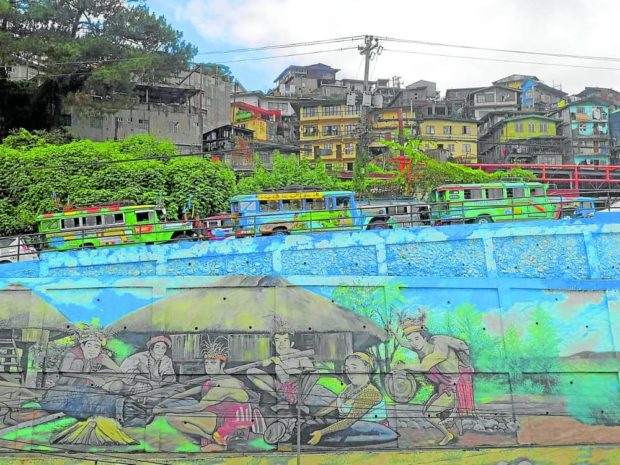
PUBLIC ART | Baguio City has lifted its cap on tourist arrivals due to the continuous decline in COVID-19 infections. Visitors will enjoy improved parks and murals like this near the public market as they go around the summer capital. (EV ESPIRITU / Inquirer Northern Luzon)
BAGUIO CITY, Benguet, Philippines — The high tourist influx in the city for the past weeks has not triggered an increase in COVID-19 infections, suggesting that vaccination and a well-managed health-care system have been effective against the disease, Mayor Benjamin Magalong said.
At the height of the pandemic from 2020 to 2021, COVID-19 transmissions increased significantly each time restrictions covering public movement were eased, Magalong told reporters this week, citing the city’s data.
But Magalong said that was not the case on the days after Baguio gradually lifted its cap on leisure travel in February while it was under alert level 2, and the subsequent weeks in March when it was classified under the least restrictive alert level 1.
On March 1, the city relaunched the Baguio Flower Festival after a two-year pause, although the event was proceeding without the crowd-drawing float and street dancing parades.
The number of visitors from March 1 to March 15 is still being consolidated, although the city receives an average of 8,000 to 9,000 daily, particularly during weekends, Magalong said.
For instance, the city tourism office screened and approved 10,282 requests to visit Baguio on Feb. 24; 21,143 on Feb. 25, a holiday; and 8,533 on Feb. 26.
THEY’RE BACK | With tourists back, a group of elderly Cordillerans will get a chance to earn again as they pose with visitors for a small fee at the entrance of the newly rehabilitated Baguio Botanical Garden. (EV ESPIRITU / Inquirer Northern Luzon)
Active infections
But only 21 active COVID-19 cases had been recorded in the city as of Tuesday, out of a total of 41,419 cases recorded since the pandemic was declared in March 2020.
Only fully vaccinated tourists are allowed to travel to the city, which may explain the improved health situation here, health officials said at a briefing on Wednesday.
But the downward trend in infections may also be due to the high number of vaccinated residents, as well as the number of recovered patients who developed natural immunity to the virus, said Dr. Bernard Demot, an epidemiologist at Baguio General Hospital and Medical Center.
Data from the city health services office showed that 279,195 of the targeted 281,000 Baguio adults had been fully vaccinated, while 33,802 minors age 12 to 17, and 2,479 children age 5 to 11 had completed their jabs as of Monday.
Tourists have also traveled to Ifugao province and to popular destinations like Sagada town in Mountain Province, but infections have relatively been at a minimum, said nurse Karen Lonogan, an epidemiologist for the Department of Health in the Cordillera.
As of Tuesday, hospitals in the Cordillera have recorded only 62 active COVID-19 cases out of 117,957 cases tallied in the region since 2020.
Good response
Except for Ifugao and Benguet, most provinces in the region have high vaccination rates led by Baguio with 104.15 percent (315,492 fully vaccinated of its expanded 2022 target of 302,911 residents) and Abra with 89.5 percent (178,617 of 199,574).
Lonogan said experts were monitoring if the downtrend in infections meant COVID-19 was evolving into an endemic disease (seasonal ailments like the common cold or the flu), given that the Cordillera’s current epidemic risk level category was minimal.
She said data analysts also take into account the modification of health restrictions as more businesses returned to full-capacity operations while under alert level 1, among them Baguio and the provinces of Apayao, Abra and Kalinga.
“In many cases, local governments now have good responses to cases, and are able to detect, isolate and treat patients in order to prevent the spread. But low trends could also mean poor detection of cases, because local officials have not actively sought them out,” Lonogan said.
RELATED STORIES
Baguio mulls daily tourist cap of 20,000
COVID-19 cases in Baguio City may have peaked — OCTA Research
Baguio welcomes visitors who need COVID-19 jabs